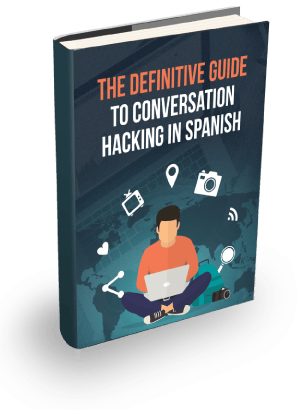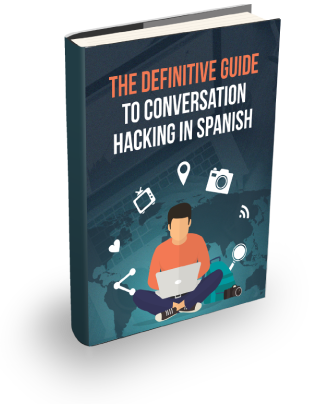I did the maths.
On average, one in four readers of this blog (data from the last 12 months) asks me about how to learn Spanish verb conjugations.
More specifically, you tell me that learning Spanish verb conjugations is one of your top three challenges with learning Spanish.
Other notable challenges include fear of making mistakes, not having enough time to practice, and not being able to find people to practice with.
At the top the list, though, is learning verb conjugations. And this makes complete sense since there is a lot to know when it comes to verb conjugations in Spanish!
In fact, there are 18 Spanish verb tenses and moods. To understand them all you need to study the differences between the subjunctive, the indicative and the imperative moods, and all of the rules for talking about the past, present and future.
So, with so much to take in, how should you learn them?
To answer this question, I reached out to some of the best language learning minds on the internet for their thoughts and opinions.
So here are the responses from the language learning experts that were kind enough to give up their time to help you with this common challenge that all Spanish students have to deal with:
Olly Richards
 The point where you begin to feel a mastery of Spanish verbs only comes from one place: usage. In other words, hearing verbs used by Spanish speakers so much that you begin to instinctively know how to conjugate them yourself.
The point where you begin to feel a mastery of Spanish verbs only comes from one place: usage. In other words, hearing verbs used by Spanish speakers so much that you begin to instinctively know how to conjugate them yourself.
You might call this the Eureka moment. A particular conjugation either sounds right or it doesn’t.
Now, this is all very well, but it’s not exactly what you’d call actionable advice!
So here’s what I’d do myself if I was starting from scratch:
1) Get a good grammar book and familiarise yourself with as many of the rules of conjugation as possible. You’re not aiming to master them, or to obsess over getting them right. (There’s simply too much to remember). Rather, you’re just “priming” your brain with the rules, so that when you encounter them in real life they’re not totally unfamiliar.
2) Moving beyond this stage and beginning to internalise the rules will not come from “study”, for the reasons outlined above. You need to get it off the page, out of the book, and in to the real world. So go out and speak, read books, watch movies, and…
3) Simply notice what verb conjugations are being use, when, and why. You won’t always get it right, but over time (and it DOES take time), and with enough ongoing attention, you’ll start to understand what sounds right and what doesn’t.
Kerstin Cable
 Cut down your requirements and prioritise the conjugations that you really need, but make sure you know all 6 of the core endings. Spanish is quite forgiving with an irregular verb as long as you get the endings right.
Cut down your requirements and prioritise the conjugations that you really need, but make sure you know all 6 of the core endings. Spanish is quite forgiving with an irregular verb as long as you get the endings right.
Embrace verb groups – they’re a huge help in the Spanish language and will give you a sense of navigation around the language. So watch out and notice when a verb ending points at a conjugation with -er, -ar and so on.
Lindsay Dow

When I first started learning Spanish, things were very different to how they are now. Apps, iPads, and italki weren’t in my everyday vocabulary and the majority of my verb conjugations were learnt from writing and re-writing verb tables. And re-writing. And re-writing. And it still wasn’t until I spent some time living in Costa Rica and later when I began to teach Spanish that everything became more and more rock solid.
So based on that, my advice would be to get out there, get speaking with real people, and you’ll find yourself using (+ remembering) the verbs you need. The rest will fill in the gaps as and when it’s necessary.
The other thing I’d recommend is the “rubber duck” method – imagine you’re explaining complicated theories and verb conjugations to a rubber duck…because, it may come as a surprise to hear, rubber ducks can’t speak Spanish, so you’ll have to bring things way back to basics to get your point across. Rebuilding the roots, so to speak, can be beneficial to increasing your Spanish verb knowledge.
Steve Kaufmann
 You can’t learn them, up front. Be aware that the verbs change. Don’t try to learn them or ace them. Read and listen a lot. Try to notice the way the verbs change when you read and listen. With enough reading and listening you will get better and better at identifying the endings. You will get used to them. They will start to sound natural. Eventually you will be able to use them, not perfectly, but better and better. So to learn them, just don’t study them.
You can’t learn them, up front. Be aware that the verbs change. Don’t try to learn them or ace them. Read and listen a lot. Try to notice the way the verbs change when you read and listen. With enough reading and listening you will get better and better at identifying the endings. You will get used to them. They will start to sound natural. Eventually you will be able to use them, not perfectly, but better and better. So to learn them, just don’t study them.
Daniel Welsch
 I had a couple of pretty good teachers back in high school, and I learned most of the verb conjugations back then. I specifically remember memorizing the -ar verbs’ endings like a rap song, with rhythm. O – As – A, Amos – Áis – An. Otherwise, I think the secret was just listening to the teacher explain it, and then starting to speak pretty soon after I got out of high school.
I had a couple of pretty good teachers back in high school, and I learned most of the verb conjugations back then. I specifically remember memorizing the -ar verbs’ endings like a rap song, with rhythm. O – As – A, Amos – Áis – An. Otherwise, I think the secret was just listening to the teacher explain it, and then starting to speak pretty soon after I got out of high school.
Speaking is what really works. At the start it wasn’t easy, I remember I had to have people repeat things twice, once to understand the verb and the second time to decipher the conjugation and figure out who it referred to. But it worked over time, practice makes perfect!
Summary and your turn
Thank you so much to the experts for taking the time to contribute to this post. I really appreciate your help!
To you the reader, it seemed that a common theme that ran throughout all 5 responses was to use what you know. In other words, don’t just study Spanish verb conjugations but get out and use them in the real world with real people.
So when will you next get the opportunity to use what you already know about Spanish verb conjugations?
How can you create more opportunities to use what you know no matter where you live?
And lastly, what’s your top tips for learning Spanish verb conjugations? What has worked for you?




Date a Spaniard and you can improve your Spanish very quickly. 😉
Thanks for sharing! I’m not sure I know which is harder though: learning Spanish or finding a Spanish date? 🙂
and dealing with the temperament Jajajajajaja ^^ totally worth it though <3
I fully agree with learning the basics to get an overall picture and most common verb conjugations first. Observing the differences (and irregularities) and starting to become familiar with them. Thinking of situations of a circumstance when you need to speak in a certain tense, then actually trying to talk about that situation, is a really effective way to remember them faster and build your confidence.
¡Genial! Thanks for sharing Amy!
Hi! Thanks for these excellent tips for learning Spanish verb conjugations. I agree this is not easy. Conjugating verbs is one of the most challenging parts of learning Spanish as a second language. I agree with Steve Kaufmann. Read and listen a lot. With enough reading and listening you will get better and better. VidaLingua also has an article you can read about verb conjugations (See here: https://vidalingua.com/blog/spanish-verb-conjugation-tenses ). The real big thing in language learning is motivation.
Thanks for sharing Paul!
Yw. More power to you Andrew!
All five responses from language learning experts are beneficial.
I agree with Steve Kaufmann; when I was learning other languages, I had the same experience. I found that reading and listening a lot helped me. I also try to notice how the verbs change when I read and listen… After that, I grew accustomed to them.
Thanks for sharing Kaylee!! 🙂
WOW! That was a tough one! I’m a total beginner, so I imagine it will make more sense as I learn down the road.
Thanks for the comment Steph! 🙂